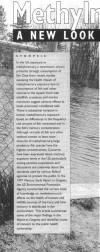Abstract
In the US, exposure to methylmercury, a neurotoxin, occurs primarily through consumption of fish. Data from recent studies assessing the health impact of methylmercury exposure due to consumption of fish and other sources in the aquatic food web (shellfish, crustacea, and marine mammals) suggest adverse effects at levels previously considered safe. There is substantial variation in human methylmercury exposure based on differences in the frequency and amount of fish consumed and in the fish's mercury concentration. Although virtually all fish and other seafood contain at least trace amounts of methylmercury, large predatory fish species have the highest concentrations. Concerns have been expressed about mercury exposure levels in the US, particularly among sensitive populations, and discussions are underway about the standards used by various federal agencies to protect the public. In the 1997 Mercury Study Report to Congress, the US Environmental Protection Agency summarized the current state of knowledge on methylmercury's effects on the health of humans and wildlife; sources of mercury; and how mercury is distributed in the environment. This article summarizes some of the major findings in the Report to Congress and identifies issues of concern to the public health community.
Full text
PDF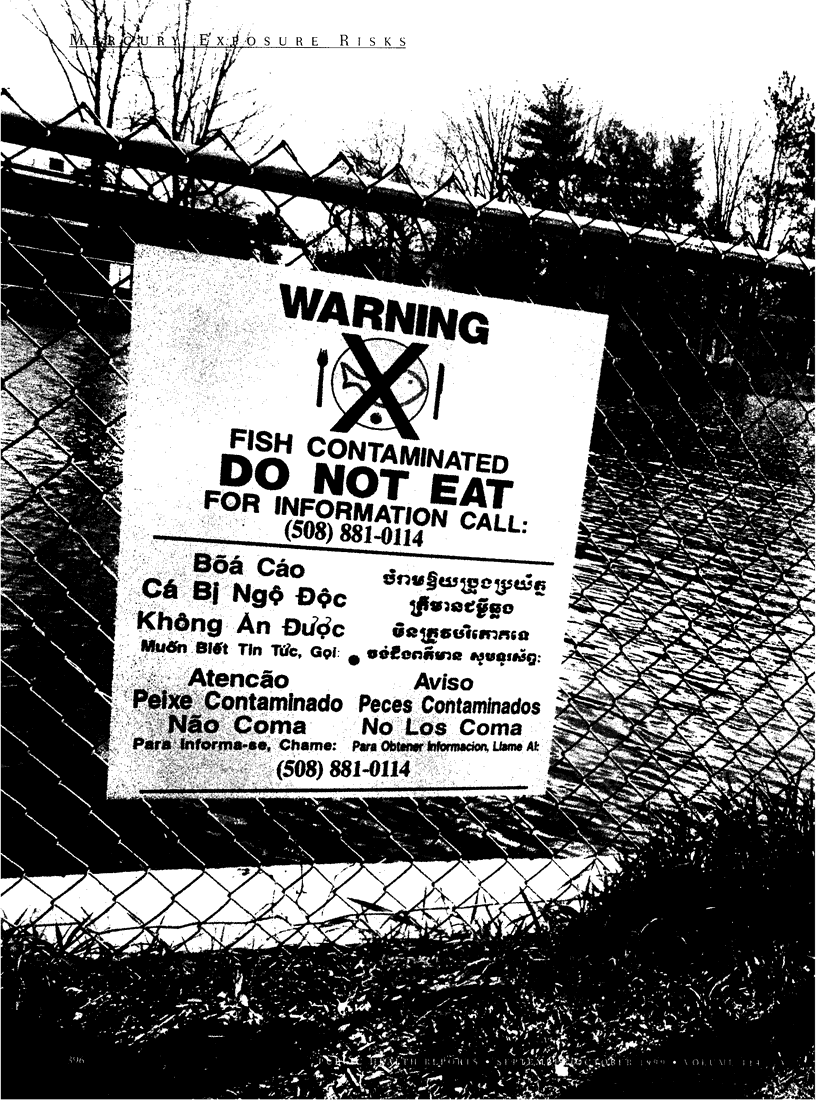
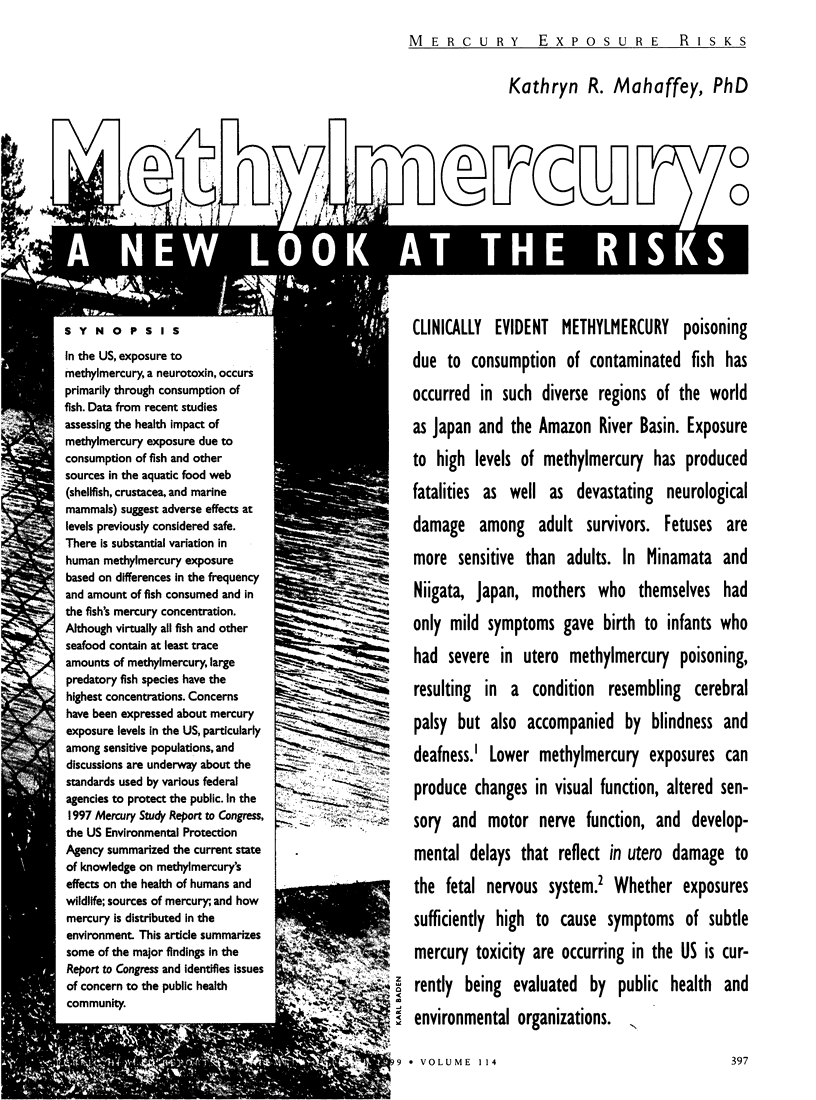


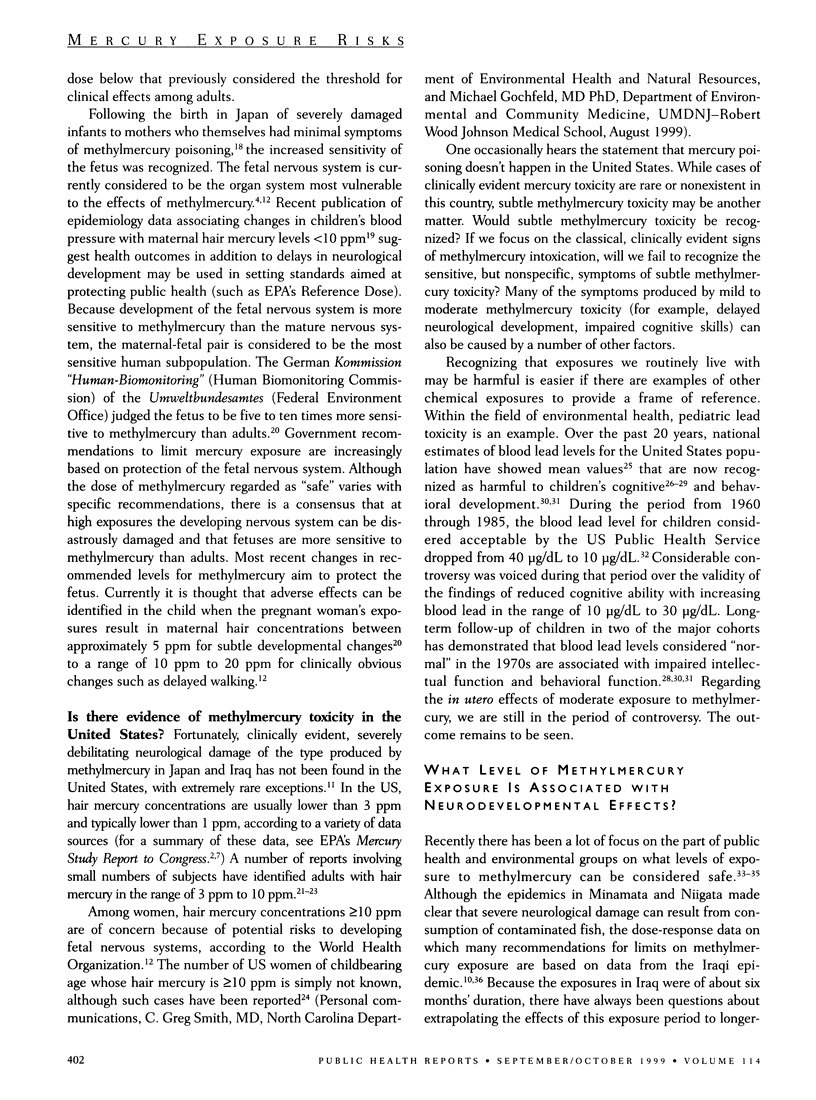
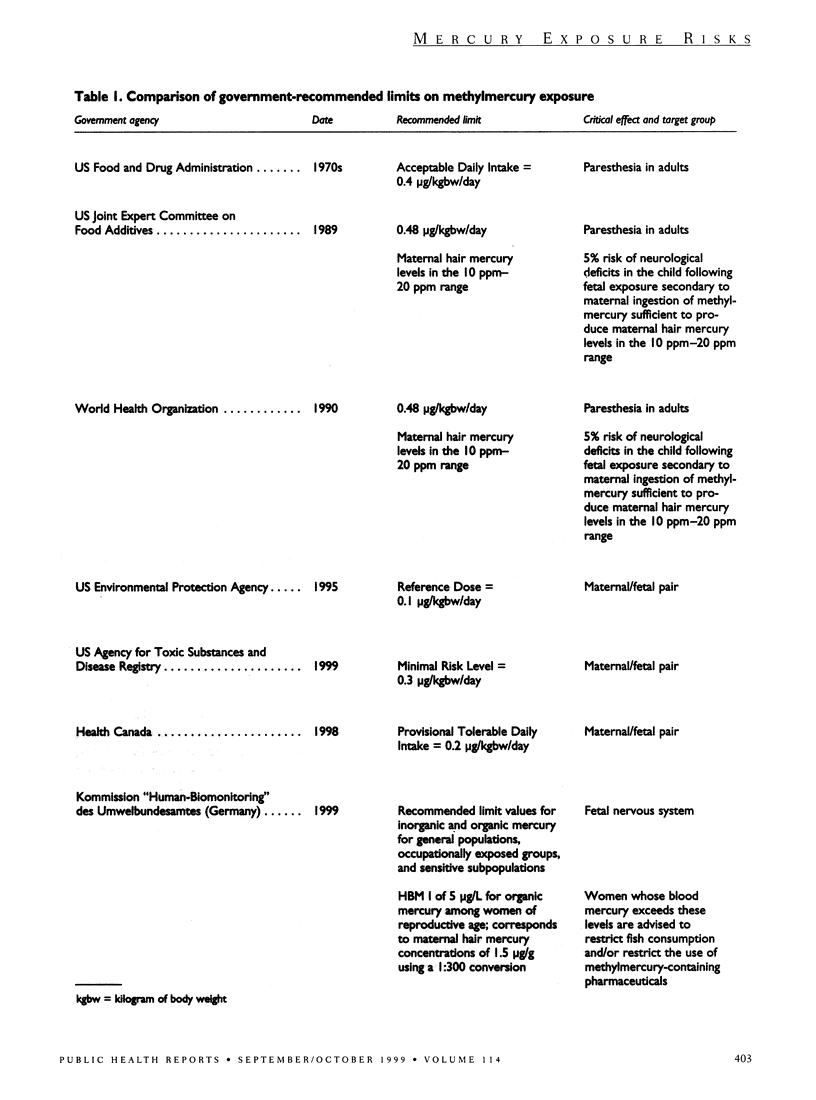
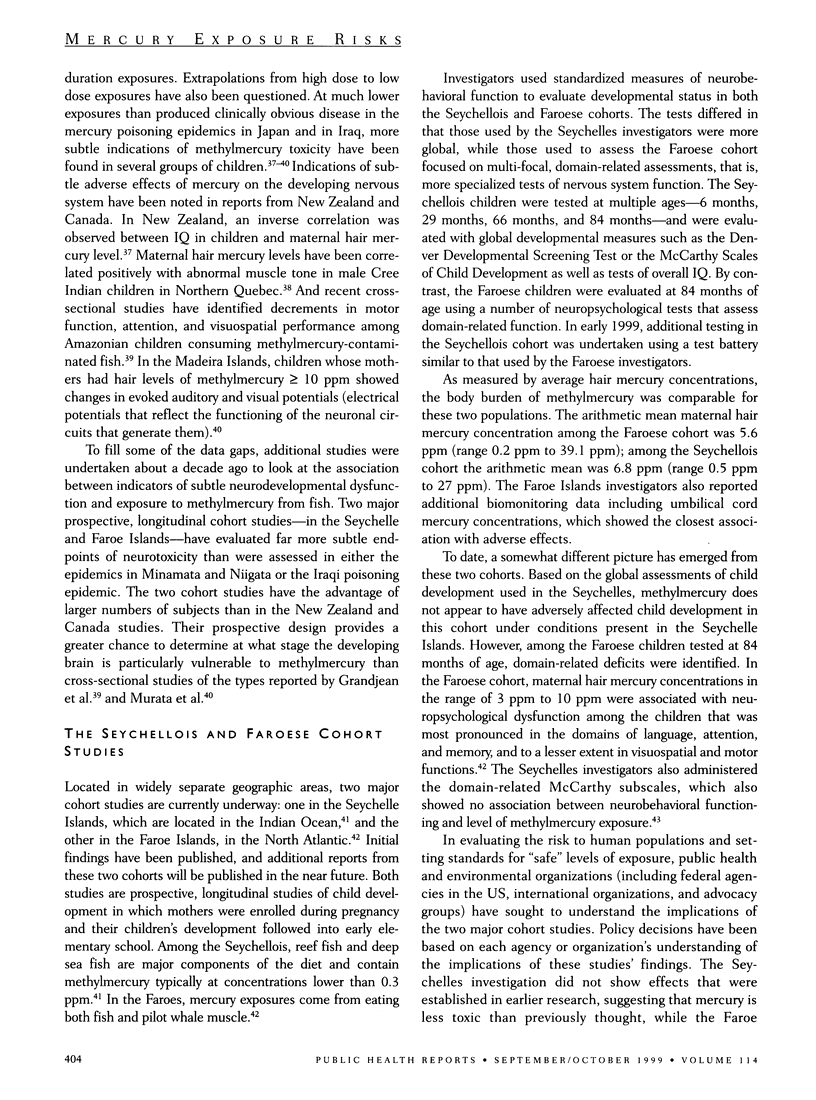
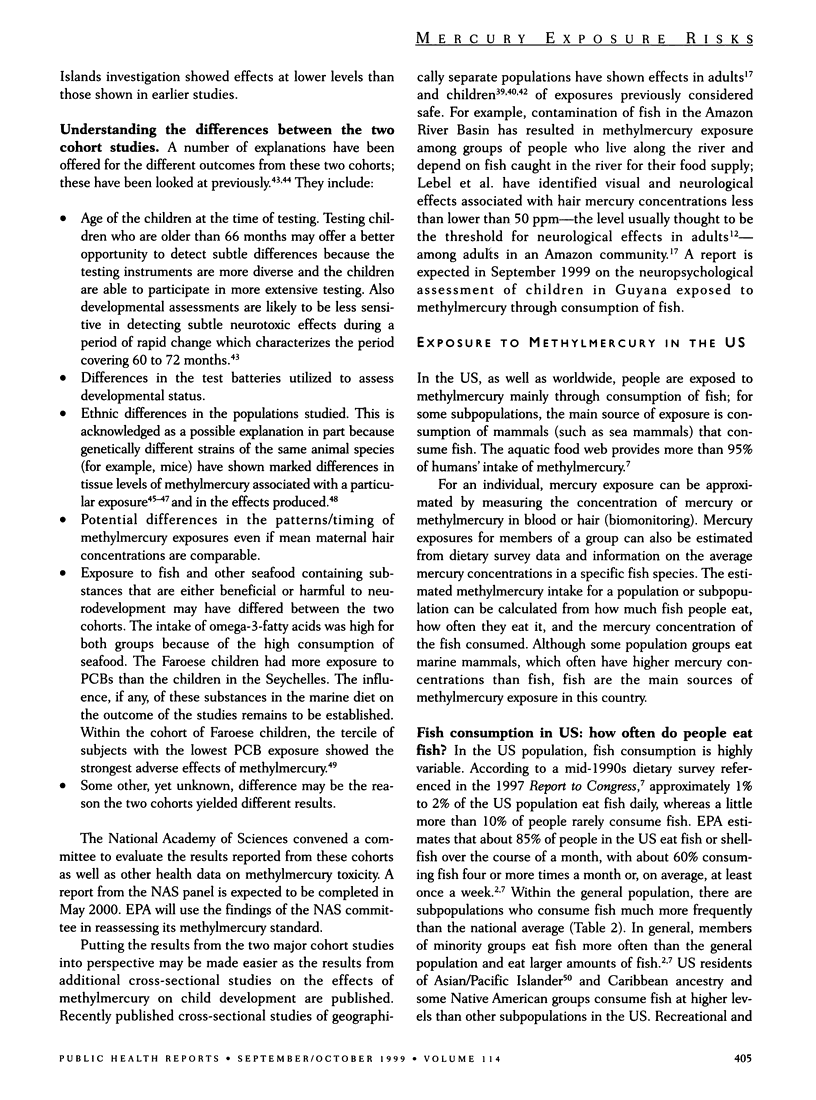
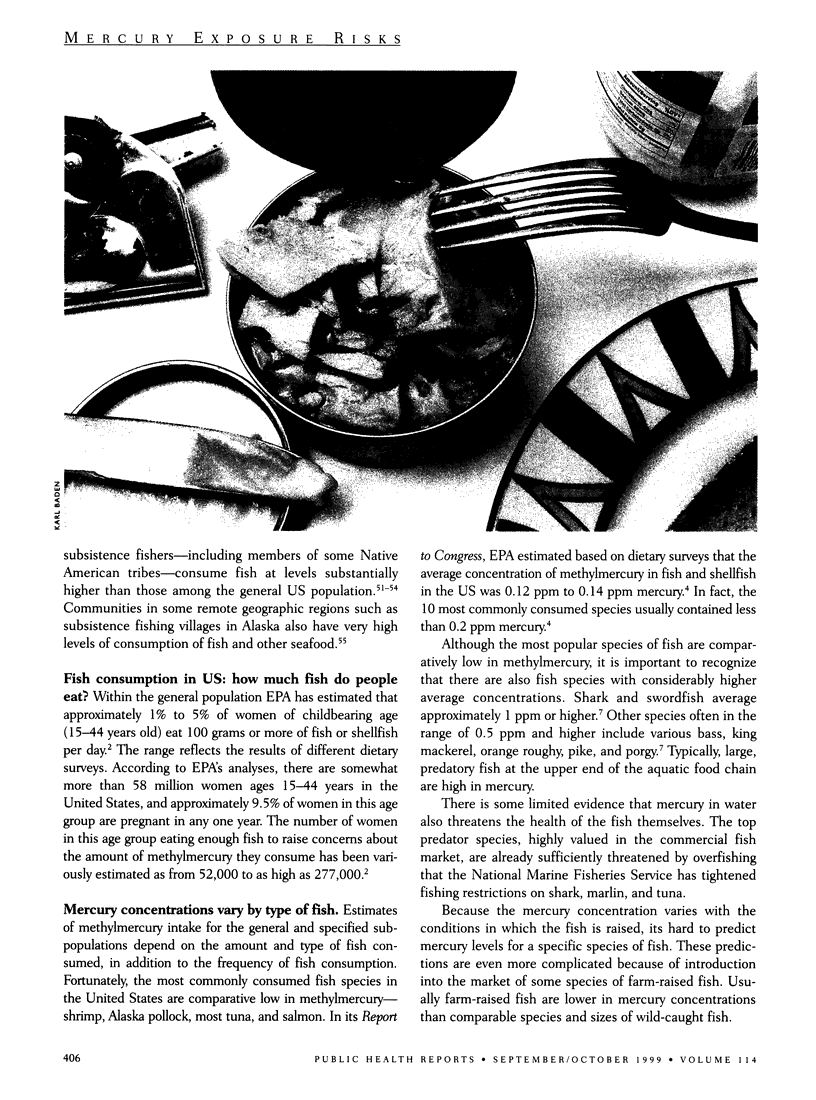
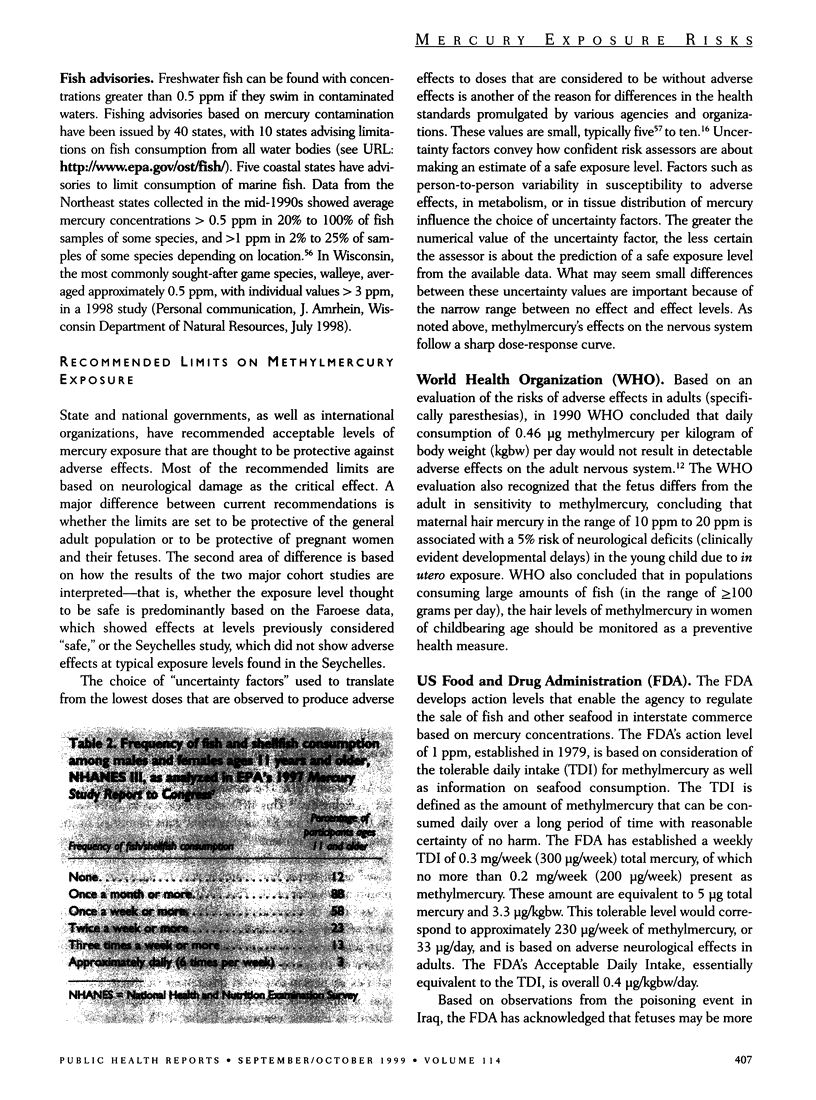
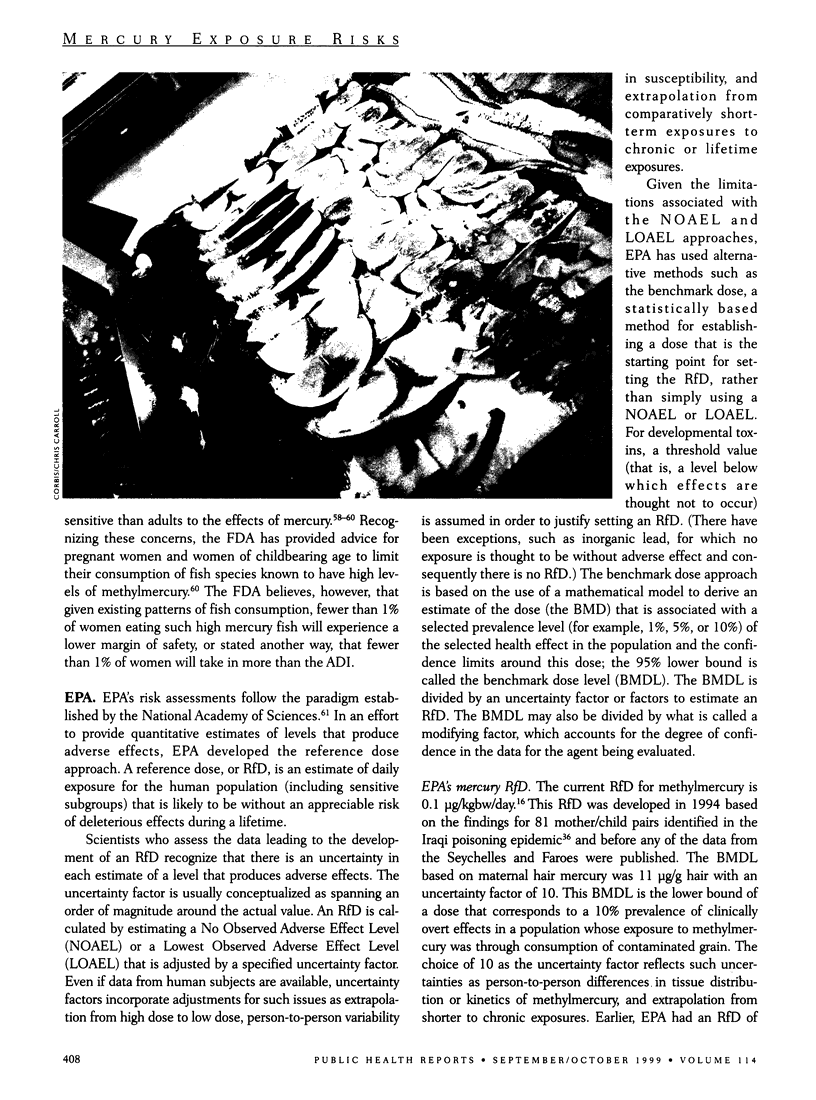
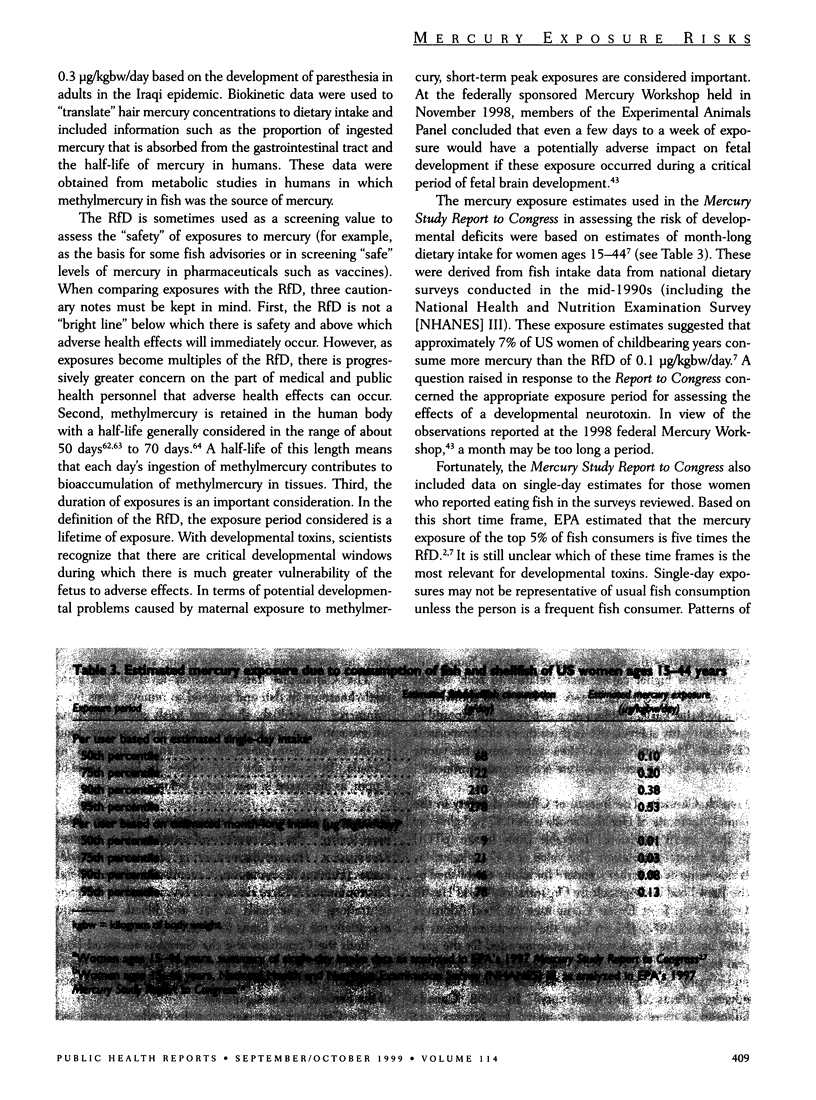
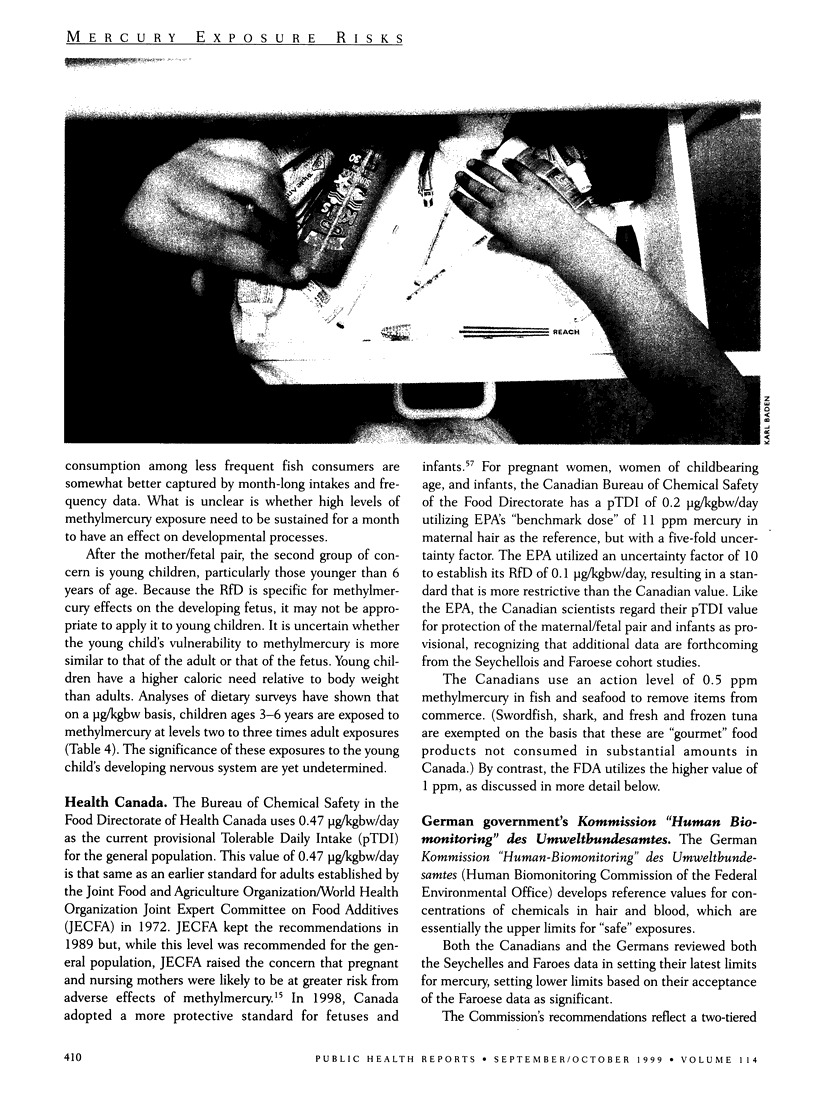
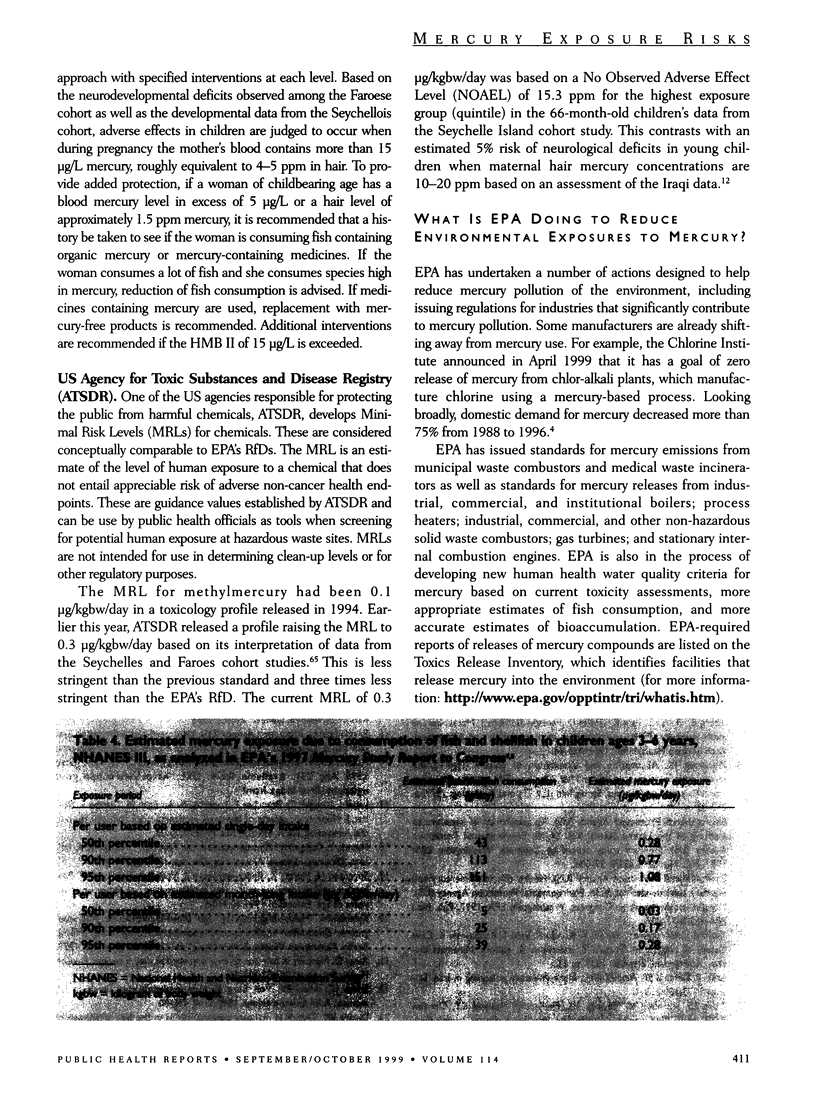
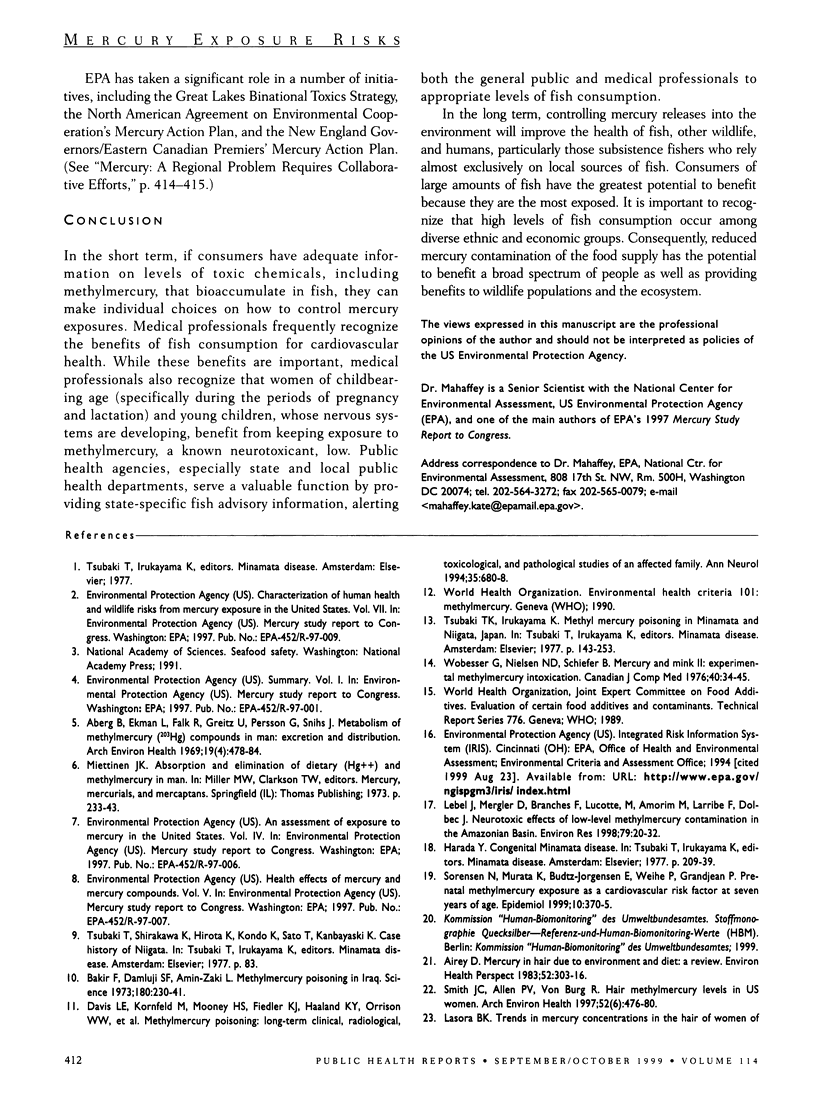
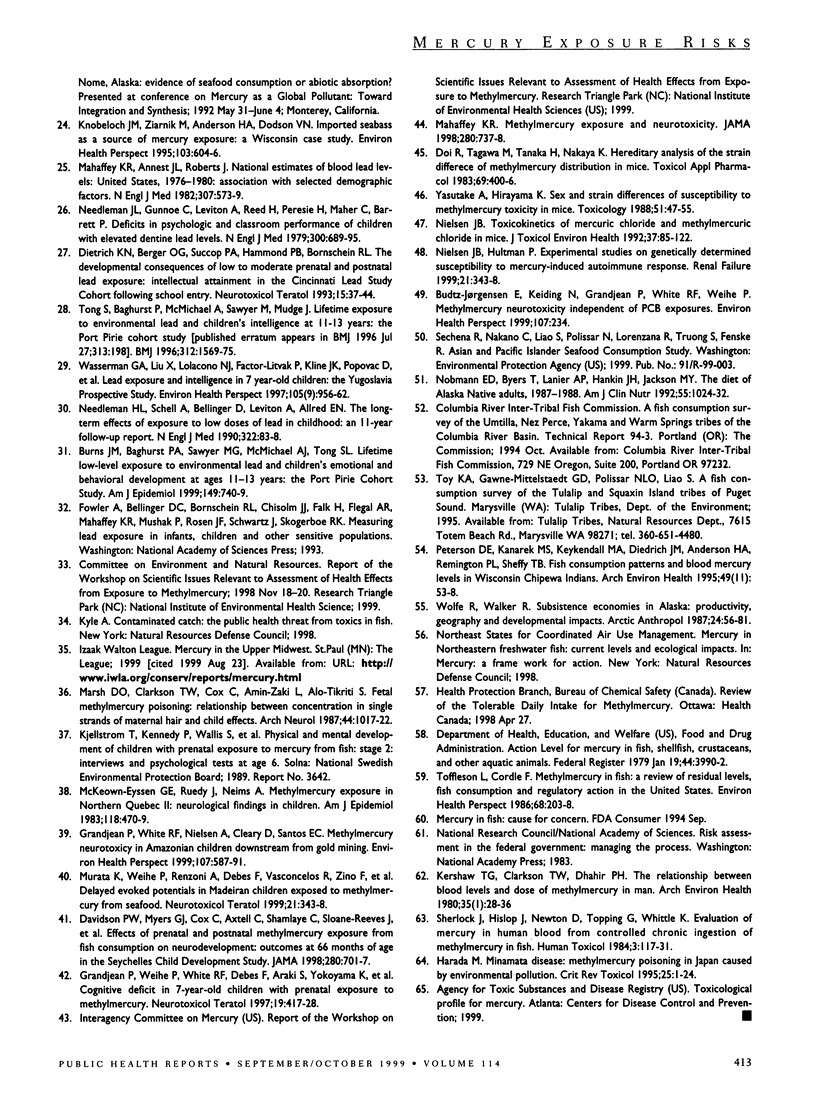
Images in this article
Selected References
These references are in PubMed. This may not be the complete list of references from this article.
- Aberg B., Ekman L., Falk R., Greitz U., Persson G., Snihs J. O. Metabolism of methyl mercury (203Hg) compounds in man. Arch Environ Health. 1969 Oct;19(4):478–484. doi: 10.1080/00039896.1969.10666872. [DOI] [PubMed] [Google Scholar]
- Airey D. Mercury in human hair due to environment and diet: a review. Environ Health Perspect. 1983 Oct;52:303–316. doi: 10.1289/ehp.8352303. [DOI] [PMC free article] [PubMed] [Google Scholar]
- Bakir F., Damluji S. F., Amin-Zaki L., Murtadha M., Khalidi A., al-Rawi N. Y., Tikriti S., Dahahir H. I., Clarkson T. W., Smith J. C. Methylmercury poisoning in Iraq. Science. 1973 Jul 20;181(4096):230–241. doi: 10.1126/science.181.4096.230. [DOI] [PubMed] [Google Scholar]
- Burns J. M., Baghurst P. A., Sawyer M. G., McMichael A. J., Tong S. L. Lifetime low-level exposure to environmental lead and children's emotional and behavioral development at ages 11-13 years. The Port Pirie Cohort Study. Am J Epidemiol. 1999 Apr 15;149(8):740–749. doi: 10.1093/oxfordjournals.aje.a009883. [DOI] [PubMed] [Google Scholar]
- Davidson P. W., Myers G. J., Cox C., Axtell C., Shamlaye C., Sloane-Reeves J., Cernichiari E., Needham L., Choi A., Wang Y. Effects of prenatal and postnatal methylmercury exposure from fish consumption on neurodevelopment: outcomes at 66 months of age in the Seychelles Child Development Study. JAMA. 1998 Aug 26;280(8):701–707. doi: 10.1001/jama.280.8.701. [DOI] [PubMed] [Google Scholar]
- Davis L. E., Kornfeld M., Mooney H. S., Fiedler K. J., Haaland K. Y., Orrison W. W., Cernichiari E., Clarkson T. W. Methylmercury poisoning: long-term clinical, radiological, toxicological, and pathological studies of an affected family. Ann Neurol. 1994 Jun;35(6):680–688. doi: 10.1002/ana.410350608. [DOI] [PubMed] [Google Scholar]
- Dietrich K. N., Berger O. G., Succop P. A., Hammond P. B., Bornschein R. L. The developmental consequences of low to moderate prenatal and postnatal lead exposure: intellectual attainment in the Cincinnati Lead Study Cohort following school entry. Neurotoxicol Teratol. 1993 Jan-Feb;15(1):37–44. doi: 10.1016/0892-0362(93)90043-n. [DOI] [PubMed] [Google Scholar]
- Doi R., Tagawa M., Tanaka H., Nakaya K. Hereditary analysis of the strain difference of methylmercury distribution in mice. Toxicol Appl Pharmacol. 1983 Jul;69(3):400–406. doi: 10.1016/0041-008x(83)90263-6. [DOI] [PubMed] [Google Scholar]
- Grandjean P., Weihe P., White R. F., Debes F., Araki S., Yokoyama K., Murata K., Sørensen N., Dahl R., Jørgensen P. J. Cognitive deficit in 7-year-old children with prenatal exposure to methylmercury. Neurotoxicol Teratol. 1997 Nov-Dec;19(6):417–428. doi: 10.1016/s0892-0362(97)00097-4. [DOI] [PubMed] [Google Scholar]
- Grandjean P., White R. F., Nielsen A., Cleary D., de Oliveira Santos E. C. Methylmercury neurotoxicity in Amazonian children downstream from gold mining. Environ Health Perspect. 1999 Jul;107(7):587–591. doi: 10.1289/ehp.99107587. [DOI] [PMC free article] [PubMed] [Google Scholar]
- Harada M. Minamata disease: methylmercury poisoning in Japan caused by environmental pollution. Crit Rev Toxicol. 1995;25(1):1–24. doi: 10.3109/10408449509089885. [DOI] [PubMed] [Google Scholar]
- Kershaw T. G., Clarkson T. W., Dhahir P. H. The relationship between blood levels and dose of methylmercury in man. Arch Environ Health. 1980 Jan-Feb;35(1):28–36. doi: 10.1080/00039896.1980.10667458. [DOI] [PubMed] [Google Scholar]
- Knobeloch L. M., Ziarnik M., Anderson H. A., Dodson V. N. Imported seabass as a source of mercury exposure: a Wisconsin case study. Environ Health Perspect. 1995 Jun;103(6):604–606. doi: 10.1289/ehp.95103604. [DOI] [PMC free article] [PubMed] [Google Scholar]
- Lebel J., Mergler D., Branches F., Lucotte M., Amorim M., Larribe F., Dolbec J. Neurotoxic effects of low-level methylmercury contamination in the Amazonian Basin. Environ Res. 1998 Oct;79(1):20–32. doi: 10.1006/enrs.1998.3846. [DOI] [PubMed] [Google Scholar]
- Mahaffey K. R., Annest J. L., Roberts J., Murphy R. S. National estimates of blood lead levels: United States, 1976-1980: association with selected demographic and socioeconomic factors. N Engl J Med. 1982 Sep 2;307(10):573–579. doi: 10.1056/NEJM198209023071001. [DOI] [PubMed] [Google Scholar]
- Marsh D. O., Clarkson T. W., Cox C., Myers G. J., Amin-Zaki L., Al-Tikriti S. Fetal methylmercury poisoning. Relationship between concentration in single strands of maternal hair and child effects. Arch Neurol. 1987 Oct;44(10):1017–1022. doi: 10.1001/archneur.1987.00520220023010. [DOI] [PubMed] [Google Scholar]
- McKeown-Eyssen G. E., Ruedy J., Neims A. Methyl mercury exposure in northern Quebec. II. Neurologic findings in children. Am J Epidemiol. 1983 Oct;118(4):470–479. doi: 10.1093/oxfordjournals.aje.a113652. [DOI] [PubMed] [Google Scholar]
- Murata K., Weihe P., Renzoni A., Debes F., Vasconcelos R., Zino F., Araki S., Jørgensen P. J., White R. F., Grandjean P. Delayed evoked potentials in children exposed to methylmercury from seafood. Neurotoxicol Teratol. 1999 Jul-Aug;21(4):343–348. doi: 10.1016/s0892-0362(99)00011-2. [DOI] [PubMed] [Google Scholar]
- Needleman H. L., Gunnoe C., Leviton A., Reed R., Peresie H., Maher C., Barrett P. Deficits in psychologic and classroom performance of children with elevated dentine lead levels. N Engl J Med. 1979 Mar 29;300(13):689–695. doi: 10.1056/NEJM197903293001301. [DOI] [PubMed] [Google Scholar]
- Needleman H. L., Schell A., Bellinger D., Leviton A., Allred E. N. The long-term effects of exposure to low doses of lead in childhood. An 11-year follow-up report. N Engl J Med. 1990 Jan 11;322(2):83–88. doi: 10.1056/NEJM199001113220203. [DOI] [PubMed] [Google Scholar]
- Nielsen J. B., Hultman P. Experimental studies on genetically determined susceptibility to mercury-induced autoimmune response. Ren Fail. 1999 May-Jul;21(3-4):343–348. doi: 10.3109/08860229909085097. [DOI] [PubMed] [Google Scholar]
- Nielsen J. B. Toxicokinetics of mercuric chloride and methylmercuric chloride in mice. J Toxicol Environ Health. 1992 Sep;37(1):85–122. doi: 10.1080/15287399209531659. [DOI] [PubMed] [Google Scholar]
- Nobmann E. D., Byers T., Lanier A. P., Hankin J. H., Jackson M. Y. The diet of Alaska Native adults: 1987-1988. Am J Clin Nutr. 1992 May;55(5):1024–1032. doi: 10.1093/ajcn/55.5.1024. [DOI] [PubMed] [Google Scholar]
- Peterson D. E., Kanarek M. S., Kuykendall M. A., Diedrich J. M., Anderson H. A., Remington P. L., Sheffy T. B. Fish consumption patterns and blood mercury levels in Wisconsin Chippewa Indians. Arch Environ Health. 1994 Jan-Feb;49(1):53–58. doi: 10.1080/00039896.1994.9934415. [DOI] [PubMed] [Google Scholar]
- Sherlock J., Hislop J., Newton D., Topping G., Whittle K. Elevation of mercury in human blood from controlled chronic ingestion of methylmercury in fish. Hum Toxicol. 1984 Apr;3(2):117–131. doi: 10.1177/096032718400300205. [DOI] [PubMed] [Google Scholar]
- Smith J. C., Allen P. V., Von Burg R. Hair methylmercury levels in U.S. women. Arch Environ Health. 1997 Nov-Dec;52(6):476–480. doi: 10.1080/00039899709602227. [DOI] [PubMed] [Google Scholar]
- Sørensen N., Murata K., Budtz-Jørgensen E., Weihe P., Grandjean P. Prenatal methylmercury exposure as a cardiovascular risk factor at seven years of age. Epidemiology. 1999 Jul;10(4):370–375. [PubMed] [Google Scholar]
- Tollefson L., Cordle F. Methylmercury in fish: a review of residue levels, fish consumption and regulatory action in the United States. Environ Health Perspect. 1986 Sep;68:203–208. doi: 10.1289/ehp.8668203. [DOI] [PMC free article] [PubMed] [Google Scholar]
- Tong S., Baghurst P., McMichael A., Sawyer M., Mudge J. Lifetime exposure to environmental lead and children's intelligence at 11-13 years: the Port Pirie cohort study. BMJ. 1996 Jun 22;312(7046):1569–1575. doi: 10.1136/bmj.312.7046.1569. [DOI] [PMC free article] [PubMed] [Google Scholar]
- Wasserman G. A., Liu X., Lolacono N. J., Factor-Litvak P., Kline J. K., Popovac D., Morina N., Musabegovic A., Vrenezi N., Capuni-Paracka S. Lead exposure and intelligence in 7-year-old children: the Yugoslavia Prospective Study. Environ Health Perspect. 1997 Sep;105(9):956–962. doi: 10.1289/ehp.97105956. [DOI] [PMC free article] [PubMed] [Google Scholar]
- Wobeser G., Nielsen N. O., Schiefer B. Mercury and Mink. II. Experimental methyl mercury intoxication. Can J Comp Med. 1976 Jan;40(1):34–45. [PMC free article] [PubMed] [Google Scholar]
- Yasutake A., Hirayama K. Sex and strain differences of susceptibility to methylmercury toxicity in mice. Toxicology. 1988 Sep;51(1):47–55. doi: 10.1016/0300-483x(88)90079-0. [DOI] [PubMed] [Google Scholar]




